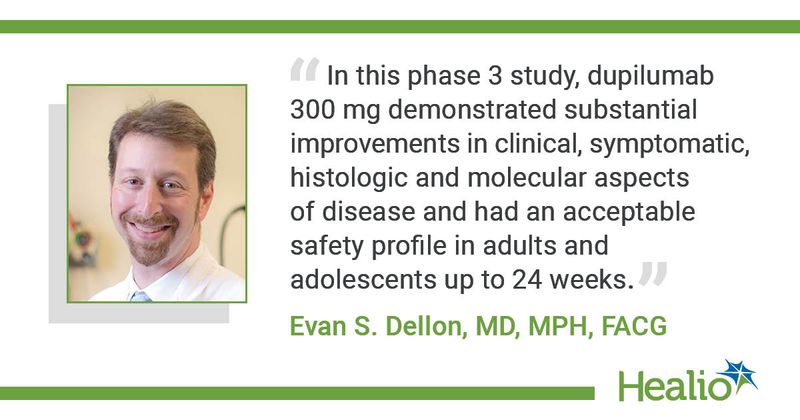Dupixent maintains long-term safety, efficacy in patients with EoE
CHARLOTTE, N.C. — Dupilumab maintains its safety and efficacy for up to 52 weeks in patients with eosinophilic esophagitis, according to late-breaking data from the phase 3 LIBERTY EoE TREET study presented at ACG Annual Scientific Meeting.
“As this audience knows, EoE is a chronic, progressive type 2 inflammatory disease of the esophagus, and current treatment options lack specificity and present adherence challenges,” Evan S. Dellon, MD, MPH, FACG, professor of medicine and adjunct professor of epidemiology in the Center for Esophageal Diseases and Swallowing at the University of North Carolina School of Medicine, said. “Dupilumab is a fully-human monoclonal antibody that blocks the shared component for IL-4 and IL-13, which are key drivers of type 2 inflammation in EoE, and this medication was recently FDA-approved for treatment of EoE.”

In the initial two parts of the three-part LIBERTY EoE TREET trial, Dupixent (dupilumab, Sanofi/Regeneron Pharmaceuticals) 300 mg weekly had demonstrated significant efficacy and safety up to 24 weeks in adults and adolescents with EoE, compared with placebo. For those patients who completed parts A and B of the trial, part C involved an extended active treatment period for 28 weeks with patients receiving treatment up to 52 weeks.
“We previously reported continued improvements for patients in part A going into part C in all aspects of disease, and the patients in the placebo who went on to receive dupilumab had similar results for safety and efficacy,” Dellon said. “Here we focus on patients from part B who received dupilumab or placebo in a weekly dosing and went on to part C.”
Dellon and colleagues assessed 74 patients who received weekly dupilumab from part B and continued in part C; of the 79 patients who received placebo in part B, 37 received weekly dupilumab in part C. The co-primary endpoints from part B included proportion of patients who achieved peak esophageal intraepithelial eosinophil count (<6/high power field) and absolute change from part B baseline in Dysphagia Symptom Score at week 24.
According to study results, part B baseline characteristics were comparable across patient groups. At week 52 of the part C component, 84.6% of patients who were maintained on dupilumab from part B and 67.6% of patients who transitioned from placebo in part B to dupilumab in part C achieved a peak esophageal intraepithelial eosinophil count of less than 6 per high power field.
At week 52, 100% of patients maintained on dupilumab and 78.4% of patients who transitioned from placebo achieved a peak esophageal intraepithelial eosinophil count of less than 15 per high power field. Compared with the baseline established in part B, peak eosinophil count, endoscopic reference scores, histologic scoring system grade and stage scores were reduced in both groups.
“In this phase 3 study, dupilumab 300 mg demonstrated substantial improvements in clinical, symptomatic, histologic and molecular aspects of disease and had an acceptable safety profile in adults and adolescents up to 24 weeks,” Dellon said. “These improvements were sustained or further improved up to 52 weeks in patients who completed part B and part C.”
He added: “Dupilumab also demonstrated an acceptable safety profile up to 52 weeks, and the placebo-treated patients from part B who were switched to dupilumab in part C showed similar results for efficacy to those of dupilumab-treated patients of part B. Findings in part B/C were also similar to what was reported in part A/C.”

